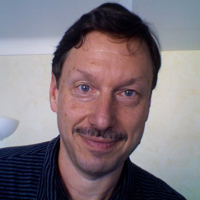Journal article by Juan José Fuldain González

Remote Sensing, 2019
The Iter 34 (Antonine Itinerary XXXIV) is the name of the Roman road that crosses the province of... more The Iter 34 (Antonine Itinerary XXXIV) is the name of the Roman road that crosses the province of Álava from west to east. Since no specific path was officially recognized before our study, the remains of the road did not benefit from heritage protection. In 2017, we made a project to determine the course of the road through rural Álava. In addition to traditional archaeological excavation and prospecting techniques, we used UAVs (unmanned aerial vehicle) to produce NDVI (normalized difference vegetation index) orthomosaic plans of ten cultivated areas through which the road is conjectured to pass. NDVI orthomosaics let us see crop marks better than with conventional photography, allowing us to detect the crop marks during times of the year and in places where conventional photography would fail to show them. Thanks to the NDVI orthomosaics, remains of the road were identified not only in places where we knew it existed, but also in previously unknown locations. Furthermore, other archaeological features were identified close to the roadway. This technique heralds a great advance in non-invasive methods of archaeological surveying. By using precision farming techniques we have identified the course of the Roman road Iter 34 in several locations in a short period of time and with few resources.

revistamapping.com, 2019
El objetivo de este experimento es comprobar la validez de la fotografía multiespectral a baja al... more El objetivo de este experimento es comprobar la validez de la fotografía multiespectral a baja altura para hacer prospecciones arqueológicas. El experimento consistió en hacer fotos multiespectrales desde RPA de diez parcelas de terreno por las que se suponía pasaba la calzada romana Iter 34 por Álava. Con dichas fotografías se procedió ha hacer orto-mosaicos georreferenciados de estas zonas y a calcular el índice NDVI, esperando que este índice mostrará en los cultivos marcas de crecimiento diferencial, de otro modo imperceptibles, correspondientes con la calzada romana. Como resultado del análisis comparativo de las fotos históricas de geoEuskadi con las fotografías NDVI se puede afirmar que las unidades estratigráfícas negativas (zanjas, pozos, silos…) dejan marcas de crecimiento positivas en NDVI y que las unidades estratigráficas positivas (muros, pavimentos, derrumbes…) dejan marcas de crecimiento negativas. En ocho de las diez zonas prospectadas se ve claramente la calzada romana, pudiendo además ver en dos de estas zonas restos de asentamientos antiguos por lo que se puede considerar que el experimento fue un éxito y que la validez de la prospección arqueológica mediante fotografía aérea a baja altura con drones y cámaras multiespectrales queda demostrada.
Arkeoikuska 2017, 2018
The intervention aimed to define (in a reliable manner) the course followed by the Iter 34, a Rom... more The intervention aimed to define (in a reliable manner) the course followed by the Iter 34, a Roman route which crossed the Province of Álava from west to east. The paper describes the historical and archaeological techniques used, and outlines the results obtained. It also presents a route calculated on the basis of the diverse documentary and material evidence accumulated.
Conference Presentations by Juan José Fuldain González

CAA UK, 2018
The Iter 34 is the Roman road that crosses the province of Álava from west to east. Since the 18t... more The Iter 34 is the Roman road that crosses the province of Álava from west to east. Since the 18th century several different routes through the area have been proposed; since no specific path is officially recognized, the remains of the road do not enjoy heritage protection.
In 2017 we made a project to determine the course of the road through rural Álava. In addition to traditional archaeological excavation and prospecting techniques, we used drones to take NDVI infrared images to create high-resolution orthomosaic plans of 10 cultivated areas through which the road is conjectured to pass. During the photosynthesis process plants reflect great amounts of infrared energy which can be captured with infrared cameras. By comparing the infrared and the visible spectrums we can clearly see the subtlest differences within the health of a crop, so that any crop marks are much clearer than in conventional photographs.
Thanks to the NDVI orthomosaics, remains of the roadway were identified not only in places where we already knew it existed but also in previously unknown locations. Furthermore, other archaeological features were identified close to the roadway.
This successful experiment heralds a great advance in non-invasive techniques of archaeological surveying. By using precision farming techniques we have identified the course of the Roman road Iter XXXIV in several locations in a short period of time and with few resources.
Papers by Juan José Fuldain González
The intervention aimed to define (in a reliable manner) the course followed by the Iter 34, a Rom... more The intervention aimed to define (in a reliable manner) the course followed by the Iter 34, a Roman route which crossed the Province of Álava from west to east. The paper describes the historical and archaeological techniques used, and outlines the results obtained. It also presents a route calculated on the basis of the diverse documentary and material evidence accumulated.
Ii Congreso Internacional Sobre Musealizacion De Yacimientos Arqueologicos Nuevos Conceptos Y Estrategias De Gestion Y Comunicacion 2003 Isbn 84 932113 8 9 Pags 275 277, 2003

The objective of this experiment was to test the validity of multispectrallow altitude photograph... more The objective of this experiment was to test the validity of multispectrallow altitude photography in archaeological surveying.The experiment involved taking multispectral photographs froma UAV of ten plots of land through which the Roman road Iter 34 isthought to have passed.These photographs were used to create georeferenced orthomosaicsof the zones and to calculate the NDVI index, anticipating thatthis index would show differencial growth marks in the crops, inperceptibleby other means, which correspond with the Roman road.A comparative analysis of the historical photographs in the geoeuskadidatabase with the NDVI photographs confirmes that negativestratigraphic features (ditches, wells, pits...) produce positive readingsin NDVI whereas positive stratigraphic features (walls, surfaces, demolitiondeposits) result in negative readings.The Roman road was seen clearly in NDVI in eight of the ten surveyedzones, furthermore two ancient settlements were identified intwo of these zones. ...

Remote Sensing
The Iter 34 (Antonine Itinerary XXXIV) is the name of the Roman road that crosses the province of... more The Iter 34 (Antonine Itinerary XXXIV) is the name of the Roman road that crosses the province of Álava from west to east. Since no specific path was officially recognized before our study, the remains of the road did not benefit from heritage protection. In 2017, we made a project to determine the course of the road through rural Álava. In addition to traditional archaeological excavation and prospecting techniques, we used UAVs (unmanned aerial vehicle) to produce NDVI (normalized difference vegetation index) orthomosaic plans of ten cultivated areas through which the road is conjectured to pass. NDVI orthomosaics let us see crop marks better than with conventional photography, allowing us to detect the crop marks during times of the year and in places where conventional photography would fail to show them. Thanks to the NDVI orthomosaics, remains of the road were identified not only in places where we knew it existed, but also in previously unknown locations. Furthermore, other a...

Today archaeologists have begun to use 3D tecniques to share the knowledge they have acquired in ... more Today archaeologists have begun to use 3D tecniques to share the knowledge they have acquired in the field with the public and institutions. Sharing the knowledge in this way facilitates the public’s understanding of archaeological sites and methods while at the same time making it entertaining. However, these new techniques are normally only used to publish the findings of archaeological studies, they do not constitute a part of those studies. At the Palaeolithic settlement of Mugarduia, as in other Palaeolithic open air sites, there are a number of pieces, but no structures, paintings or other works of art. In this case we assembled the pieces together in a 3D model. By using various symbols for the different kinds of artefacts in order to get as many maps as we required, we tried to understand the settlement and how the post depositional process had affected it. We then used realistic photo images previously taken of other settlements, intended for publication, in order to make a...












Uploads
Journal article by Juan José Fuldain González
Conference Presentations by Juan José Fuldain González
In 2017 we made a project to determine the course of the road through rural Álava. In addition to traditional archaeological excavation and prospecting techniques, we used drones to take NDVI infrared images to create high-resolution orthomosaic plans of 10 cultivated areas through which the road is conjectured to pass. During the photosynthesis process plants reflect great amounts of infrared energy which can be captured with infrared cameras. By comparing the infrared and the visible spectrums we can clearly see the subtlest differences within the health of a crop, so that any crop marks are much clearer than in conventional photographs.
Thanks to the NDVI orthomosaics, remains of the roadway were identified not only in places where we already knew it existed but also in previously unknown locations. Furthermore, other archaeological features were identified close to the roadway.
This successful experiment heralds a great advance in non-invasive techniques of archaeological surveying. By using precision farming techniques we have identified the course of the Roman road Iter XXXIV in several locations in a short period of time and with few resources.
Papers by Juan José Fuldain González
In 2017 we made a project to determine the course of the road through rural Álava. In addition to traditional archaeological excavation and prospecting techniques, we used drones to take NDVI infrared images to create high-resolution orthomosaic plans of 10 cultivated areas through which the road is conjectured to pass. During the photosynthesis process plants reflect great amounts of infrared energy which can be captured with infrared cameras. By comparing the infrared and the visible spectrums we can clearly see the subtlest differences within the health of a crop, so that any crop marks are much clearer than in conventional photographs.
Thanks to the NDVI orthomosaics, remains of the roadway were identified not only in places where we already knew it existed but also in previously unknown locations. Furthermore, other archaeological features were identified close to the roadway.
This successful experiment heralds a great advance in non-invasive techniques of archaeological surveying. By using precision farming techniques we have identified the course of the Roman road Iter XXXIV in several locations in a short period of time and with few resources.